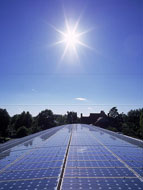The amount of venture capital invested in “clean tech” — the raft of technologies that would create a greener economy — nearly doubled from 2005 to 2006, reaching about $3 billion, according to a study conducted at the University of California at Berkeley. Figures like these have some analysts warning that clean tech is in the throes of a bubble, which could end just like the Internet and real estate booms did — badly.
Michael DeRosa, managing director of Element Partners, based in Radnor, Pa., doesn’t buy that. A venture capitalist specializing in clean-tech investing, he sees significant differences. Unlike many of the dot-coms, clean-tech companies don’t always depend on unproven technologies or untested ways of doing business. Instead, they are often offering the latest iterations of technologies, such as solar and wind power, that have existed for decades, he pointed out at a recent Wharton conference called “Winners and Losers in Green Technologies,” sponsored by the William & Phyllis Mack Center for Technological Innovation. And unlike rising real estate prices, which were fueled by low interest rates and lax lending standards, the value of clean-tech firms isn’t supported by factors that could disappear quickly. Rather, it’s driven by forces — high energy prices and global warming — that could endure for decades.
“We see gas prices only getting worse,” with oil reserves diminishing just as demand burgeons in China, India and other developing nations, he said. “And fuel costs feed into just about everything, which means that raw-materials prices and food prices should continue to stay high, too.” All of those lofty levies should keep the attention of investors, consumers and policymakers focused on ways to make the transition to a less fossil-fuel-dependent economy. “Clean tech isn’t just environmental,” DeRosa noted. “Investing in efficiencies can relieve pricing and competitive pressures for businesses.” In theory, a company that’s paying less for fuel or electricity could see higher profit margins.
DeRosa said that investors are flocking to his field. “We saw about $3.9 billion invested in the sector in 2007 in North America alone, more than triple the investment in 2002. It’s the third largest venture sector now, behind IT and life science.” He just happens to believe that the economic and environmental realities justify investors’ enthusiasm and that the demand for cleaner technologies will result in many durable companies hungry for funds. “We’re seeing an accelerating rate of business formation and greater deal flow and exit opportunities,” he noted. “And the pool of seasoned entrepreneurs and experienced executives entering the space is increasing.”
Besides, he said, talk of a clean-tech bubble needs to be put in proper perspective: “If you take every cent of venture capital that’s been invested in the history of the category, it nearly equals one week of Exxon’s revenue.” Exxon earned $117 billion in the first quarter, or the equivalent of $9 billion a week. DeRosa estimated that the amount of clean-tech venture investments over the last decade was about $10 billion.
Regulations Are Key
If there’s a major uncertainty about clean tech, it’s not whether the markets will materialize, DeRosa said. It’s government regulation. New kinds of fuel and new forms of electricity generation often depend on government support during development and will continue to do so during their early stages of commercialization. But the need for subsidies would disappear if lawmakers in the United States and other countries imposed some sort of carbon tax or capped emissions and created tradable emissions permits (a so-called cap-and-trade system), DeRosa pointed out, adding that either step would make clean technologies cost-competitive with conventional fuels such as oil and coal.
Much of the current excitement in the clean-tech sector stems from new advances in iconic technologies like photovoltaic panels and wind turbines. But more humdrum endeavors, like increasing the efficiency of lighting and appliances and improving insulation, probably offer greater investment returns in the short term. “Efficiency is going to be a huge area,” DeRosa said. “There are many things that you can do right now [to reduce carbon emissions] without great cost that pay for themselves almost immediately. We’ve recently added three insulation technologies to our portfolio.”
Govi Rao, chairman and CEO of Lighting Science Group in New York, agreed that advances in workaday technologies such as lighting are the most promising source of quick returns — and he has bet his career on that idea. “At Lighting Science, we’re trying to do well by doing good, and we’re doing it one light point at a time,” he quipped. Rao’s company makes lighting, including residential bulbs, out of light-emitting diodes, commonly known as LEDs. An LED is a semiconductor that produces light when electrified.
Most household lighting today comes from incandescent bulbs — the same sort that Thomas Edison invented more than 100 years ago. They are bright and cheap but also wasteful. A compact fluorescent bulb, the most common alternative, can throw off just as much light but requires far fewer watts to do so and, unlike incandescents, doesn’t generate needless heat. Compact fluorescents initially cost more than incandescents but last much longer. Many environmentalists therefore advocate their use.
But Rao sees shortcomings to compact fluorescents, too. “They have mercury in them,” he pointed out. “I call them compact mercury bulbs.” Mercury, a heavy metal, is toxic. (Compact-fluorescent bulbs contain such a tiny amount of mercury that the U.S. Environmental Protection Agency still recommends their use, pointing out that the number one source of mercury pollution in the U.S. is power-plant emissions.)
LED bulbs use no more electricity than compact fluorescents, plus they contain no mercury and last 12 to 15 years. But they are also expensive. Lighting Science sells its bulbs for $65 each. “The LEDs are two-thirds of our costs,” Rao said, adding that these costs are expected to fall as the industry achieves greater economies of scale. He noted that promising developments along those lines have begun: “All of the streetlights in New York City are being redesigned with LEDs.” According to The New York Times, the city has about 320,000 streetlights.
More major cities must follow New York’s lead in going green and do it soon if global warming is to slow sufficiently to prevent serious climate changes. “We have to reduce greenhouse gases by 90% by 2050 to keep the temperature rise to just 2 degrees Celsius,” Rao said. “Most people think that’s impossible. I think we can get there, but we have to start today. In Europe, they’ve already started — lights go off when you leave a room even if you don’t turn them off.”
Europe Out in Front
European nations are ahead of the rest of the world in nearly every aspect of the fight against climate change. They typically impose higher gas taxes, and several countries are discussing the imposition on additional taxes on carbon emissions. On top of that, several European countries have made hefty commitments to renewable energy. German and Spain are two of the world’s largest producers of wind power, and Germany, despite its northerly location, has plowed money into solar power. According to the Earth Policy Institute, an environmental think tank in Washington, D.C., it led the world in new solar installations for much of this decade.
Elsewhere in Europe, other green technologies are getting attention. Firms in the United Kingdom are experimenting with sea-based wind turbines and even wave power, which typically relies on buoys that generate electricity as they rise and fall with the ocean. “Perhaps because we’re an island, we like offshore turbines and things bobbing in the water,” said Christopher Tchen, a partner at Carbon Limiting Technologies, a London consultancy and investment firm.
Locating wind farms offshore heads off one of the most common objections to them — that they are ugly — and exploits the plentiful ocean breezes. Wave power likewise takes advantage of the sea’s constant crash and churn. But neither technology is a sure bet. “The sea is a hostile place,” Tchen noted. “When you’re in the sea, you have to think about things like how quickly the equipment rusts, how you’re going to maintain it and how much that’ll cost.”
Rao predicted that other parts of the world would soon follow Europe’s lead in trying to rapidly stem their emissions. That situation will create great opportunities for some companies and great peril for others. “Global warming and eco-consciousness are changing the landscape,” he said. “Some large companies are paralyzed with fear. Their strategy is called ‘wait and see and let someone else go first.’ That’s fine with us. The landscape is wide open, and there’s a tremendous land grab going on in lighting and lighting controls.”
Tchen expressed more optimism that established firms would soon go green, if for no other reason than that it will save them money. “A good cost analysis gets their attention,” he said. “We had this chocolate manufacturer, and we were able to show them that two-thirds of their cost base was energy related. Costs are risks. Cost analysis can have a big impact in a corporate context.”
In the meantime, policymakers in the West may have to give corporations a nudge by redefining property rights, said Sidney G. Winter, a Wharton management professor. “Property rights, traditionally understood, have worked well for us so far, and we haven’t had to couple them with property responsibilities.” Thus, people haven’t generally had to pay for the environmental cost of their actions. They enjoy, for example, the right to drive their cars anywhere on the public roads but don’t have to take financial responsibility for their carbon emissions. “The ability to dispose of waste used to seem limitless,” Winter added. “But now we have to institutionalize the pricing of ‘bads’ along with the pricing of goods. Maybe the way that we do that is with a cap-and-trade system. Maybe it’s with a carbon tax.”



